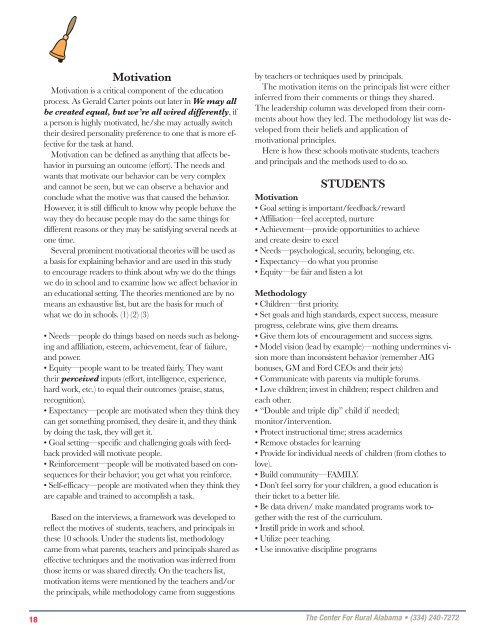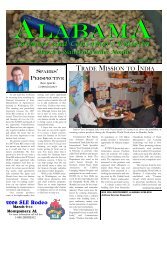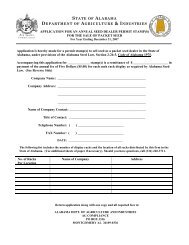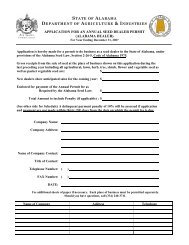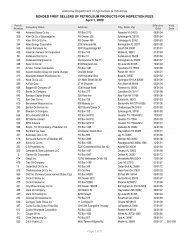Lessons Learned from Rural Schools - Alabama Department of ...
Lessons Learned from Rural Schools - Alabama Department of ...
Lessons Learned from Rural Schools - Alabama Department of ...
Create successful ePaper yourself
Turn your PDF publications into a flip-book with our unique Google optimized e-Paper software.
LLS-0010 <strong>Lessons</strong> <strong>Learned</strong>_Pub.qrk: 4/25/09 3:02 PM Page 18<br />
18<br />
Motivation<br />
Motivation is a critical component <strong>of</strong> the education<br />
process. As Gerald Carter points out later in We may all<br />
be created equal, but we’re all wired differently, if<br />
a person is highly motivated, he/she may actually switch<br />
their desired personality preference to one that is more effective<br />
for the task at hand.<br />
Motivation can be defined as anything that affects behavior<br />
in pursuing an outcome (effort). The needs and<br />
wants that motivate our behavior can be very complex<br />
and cannot be seen, but we can observe a behavior and<br />
conclude what the motive was that caused the behavior.<br />
However, it is still difficult to know why people behave the<br />
way they do because people may do the same things for<br />
different reasons or they may be satisfying several needs at<br />
one time.<br />
Several prominent motivational theories will be used as<br />
a basis for explaining behavior and are used in this study<br />
to encourage readers to think about why we do the things<br />
we do in school and to examine how we affect behavior in<br />
an educational setting. The theories mentioned are by no<br />
means an exhaustive list, but are the basis for much <strong>of</strong><br />
what we do in schools. (1) (2) (3)<br />
• Needs—people do things based on needs such as belonging<br />
and affiliation, esteem, achievement, fear <strong>of</strong> failure,<br />
and power.<br />
• Equity—people want to be treated fairly. They want<br />
their perceived inputs (effort, intelligence, experience,<br />
hard work, etc.) to equal their outcomes (praise, status,<br />
recognition).<br />
• Expectancy—people are motivated when they think they<br />
can get something promised, they desire it, and they think<br />
by doing the task, they will get it.<br />
• Goal setting—specific and challenging goals with feedback<br />
provided will motivate people.<br />
• Reinforcement—people will be motivated based on consequences<br />
for their behavior; you get what you reinforce.<br />
• Self-efficacy—people are motivated when they think they<br />
are capable and trained to accomplish a task.<br />
Based on the interviews, a framework was developed to<br />
reflect the motives <strong>of</strong> students, teachers, and principals in<br />
these 10 schools. Under the students list, methodology<br />
came <strong>from</strong> what parents, teachers and principals shared as<br />
effective techniques and the motivation was inferred <strong>from</strong><br />
those items or was shared directly. On the teachers list,<br />
motivation items were mentioned by the teachers and/or<br />
the principals, while methodology came <strong>from</strong> suggestions<br />
by teachers or techniques used by principals.<br />
The motivation items on the principals list were either<br />
inferred <strong>from</strong> their comments or things they shared.<br />
The leadership column was developed <strong>from</strong> their comments<br />
about how they led. The methodology list was developed<br />
<strong>from</strong> their beliefs and application <strong>of</strong><br />
motivational principles.<br />
Here is how these schools motivate students, teachers<br />
and principals and the methods used to do so.<br />
STUDENTS<br />
Motivation<br />
• Goal setting is important/feedback/reward<br />
• Affiliation—feel accepted, nurture<br />
• Achievement—provide opportunities to achieve<br />
and create desire to excel<br />
• Needs—psychological, security, belonging, etc.<br />
• Expectancy—do what you promise<br />
• Equity—be fair and listen a lot<br />
Methodology<br />
• Children—first priority.<br />
• Set goals and high standards, expect success, measure<br />
progress, celebrate wins, give them dreams.<br />
• Give them lots <strong>of</strong> encouragement and success signs.<br />
• Model vision (lead by example)—nothing undermines vision<br />
more than inconsistent behavior (remember AIG<br />
bonuses, GM and Ford CEOs and their jets)<br />
• Communicate with parents via multiple forums.<br />
• Love children; invest in children; respect children and<br />
each other.<br />
• “Double and triple dip” child if needed;<br />
monitor/intervention.<br />
• Protect instructional time; stress academics<br />
• Remove obstacles for learning<br />
• Provide for individual needs <strong>of</strong> children (<strong>from</strong> clothes to<br />
love).<br />
• Build community—FAMILY.<br />
• Don’t feel sorry for your children, a good education is<br />
their ticket to a better life.<br />
• Be data driven/ make mandated programs work together<br />
with the rest <strong>of</strong> the curriculum.<br />
• Instill pride in work and school.<br />
• Utilize peer teaching.<br />
• Use innovative discipline programs<br />
The Center For <strong>Rural</strong> <strong>Alabama</strong> • (334) 240-7272


